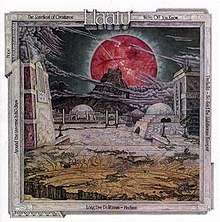Hope (Klaatu album)
| Hope | ||||
|---|---|---|---|---|
 | ||||
| Studio album by Klaatu | ||||
| Released | September 1977 | |||
| Recorded | June 1976 – June 1977 [1] | |||
| Genre | ||||
| Length | 41:11 (including hidden track) | |||
| Label | Daffodil, Capitol | |||
| Producer | Terry Brown | |||
| Klaatu chronology | ||||
| ||||
| Professional ratings | |
|---|---|
| Review scores | |
| Source | Rating |
| Peter Kurtz, Allmusic | |
| Dave Sleger, Allmusic | |
Hope, released in September 1977, is the second album by the Canadian progressive rock group Klaatu. It is a concept album, recorded with the London Symphony Orchestra, about the sole survivor of an arrogant race of beings, who warns space travellers of hazards in the last days of his life.
Many fans and critics consider Hope to be the most creative of the Klaatu albums.
It won a Juno Award for "Best Engineered Album" and a Canadian Music Critics award for "Best Album" in 1977.
An alternate version of Hope was released in 2005 as part of the group's Sun Set collection of rarities. The alternate version on Sun Set included the complete contributions of the London Symphony Orchestra, which had largely been removed from the version released in 1977. The alternate version also includes a short unreleased track, "Epilogue," which had originally been intended to be placed between "So Said the Lighthouse Keeper" and "Hope."
As with Klaatu's previous album "3:47 EST", "Hope" was remastered and re-issued in 2012 by the band's members, and was released on the band's independent record label "Klaatunes".
Musical style
Hope is a rock opera often dominated by complex orchestral sequences and arrangements. Allmusic's Mike DeGagne commented that the album was "less pop-infused" than the group's previous album 3:47 EST, and contained more "progressive depth" with an "experimental sound".[3] Peter Kurtz of the website felt that the album's conceptual rock opera theme sounded "pretentious, and in some cases like a rip-off of Queen".
Track listing
- All songs 1977 Copyright Klaatoons, Inc.
- Side one
- "We're Off You Know" – 4:02 (Woloschuk)
- "Madman" – 2:40 (Long)
- "Around the Universe in Eighty Days" – 5:02 (Long)
- "Long Live Politzania" – 9:11 (Woloschuk)
- Side two
- "The Loneliest of Creatures" – 3:52 (Woloschuk)
- "Prelude" – 5:43 (Klaatu)
- "So Said the Lighthouse Keeper" – 5:56 (Woloschuk)
- "Hope" – 4:45 (Woloschuk)
The album opens with a mouse squeak. Their previous album, 3:47 EST, ends with a mouse squeak.[4]
The original release credited all songs simply to "Klaatu"; however, subsequent reissues and the band's website provided individual song writing credits.[5]
Personnel
- Klaatu
- Dee Long - vocals, piano, electric guitar, acoustic guitar, organ, clavinet, bass guitar, synthesizer, mandolin, slide guitar, harmonica, electric sitar
- John Woloschuk - vocals, bass guitar, Fender Rhodes piano, autoharp, acoustic guitar, piano, organ, Polymoog synthesizer, harmonium, electric piano, pianet
- Terry Draper - drums, tambourine, triangle, percussion, whistle
- Additional
- Production
- Arranged & produced by Klaatu & Terry Brown
- Recorded & engineered by Terry Brown
The band members are not named on the original LP. [6]
Cover art
Like the previous Klaatu album, the cover was painted by graphic artist Ted Jones.
The cover shows "the Lighthouse Keeper's beam". The ruined stone plaza features the sun image from the cover of the previous Klaatu album.
References
- ↑ "The Morning Sun - 5th Edition". Klaatu.org. Retrieved 2016-11-16.
- 1 2 3 Dave Sleger (1992-01-06). "Klaatu/Hope - Klaatu | Songs, Reviews, Credits". AllMusic. Retrieved 2016-11-16.
- ↑ Mike DeGagne. "3:47 EST - Klaatu | Songs, Reviews, Credits". AllMusic. Retrieved 2016-11-16.
- ↑ The cover art for each album features a mouse.
- ↑ "The Official Klaatu Homepage". Klaatu.org. Retrieved 2016-11-16.
- ↑ "The Official Klaatu Homepage". Klaatu.org. Retrieved 2016-11-16.